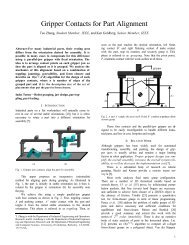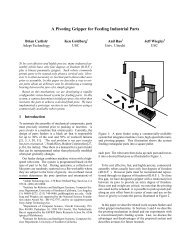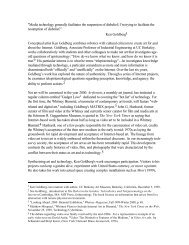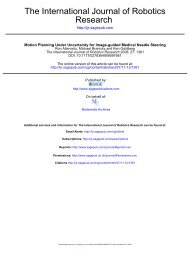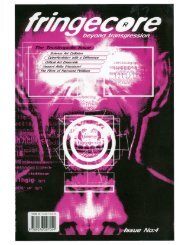“Are We There Yet?” Visual Tracking of Visitors ... - Ken Goldberg
“Are We There Yet?” Visual Tracking of Visitors ... - Ken Goldberg
“Are We There Yet?” Visual Tracking of Visitors ... - Ken Goldberg
Create successful ePaper yourself
Turn your PDF publications into a flip-book with our unique Google optimized e-Paper software.
1.6 Assumptions<br />
With this notation, we make the following assumptions:<br />
<strong>“Are</strong> <strong>We</strong> <strong>There</strong> <strong>Yet</strong>?<strong>”</strong> 9<br />
1. Foreground regions <strong>of</strong> images are small.<br />
In general, there are relatively few visitors and this assumption holds. In<br />
some anomalous circumstances, this assumption may be violated, during<br />
galas and special events. <strong>We</strong> implemented a failsafe in these circumstances<br />
to allow the system to re-initialize and recover.<br />
Let B(k) ≡ F (k) c represent the set <strong>of</strong> pixels associated with the background.<br />
Assume that |B(k)| ≫ |F (k)|.<br />
2. The color distribution <strong>of</strong> a given pixel changes slowly relative to the frame<br />
rate. The appearance is allowed to change rapidly, as with a flickering light,<br />
but the distribution <strong>of</strong> colors at a given pixel must remain essentially constant<br />
between frames. In practice, this condition is only violated in extreme<br />
situations, as when lights are turned on or <strong>of</strong>f. High-level logic helps the<br />
algorithm recover from a violation <strong>of</strong> this assumption.<br />
Interpreting Hij(k) as a vector, ∃ɛ > 0 such that for all i, j, k,<br />
||Hij(k) − Hij(k + 1)|| < ɛ, where ɛ is small.<br />
3. To limit memory requirements, we store only a small number <strong>of</strong> the total<br />
possible histogram bins. To avoid a loss <strong>of</strong> accuracy, we make an assumption<br />
that most elements <strong>of</strong> Hij(k) are 0. In other words, each pixel can only take<br />
on a few colors relative to the total number <strong>of</strong> possible colors.<br />
The support <strong>of</strong> the probability mass function Hij(k) is sparse over C.<br />
4. By starting the algorithm before visitors enter the gallery, we assume that<br />
the image sequence contains no visitors for the first few seconds.<br />
∃K > 0 such that R(k) = 0 ∀k < K.<br />
5. Pixels corresponding to visitors have a color distribution distinct from the<br />
background distribution.<br />
Consider a foreground pixel Iij(k) such that (i, j) ∈ F (k), has probability<br />
mass function Fij(k). The background distribution at the same pixel is<br />
Hij(k). Interpreting distributions as vectors, ||Fij(k)−Hij(k)|| > δ for some<br />
δ > 0. While this property is necessary in order to detect a visitor, it is not<br />
sufficient, and we use additional information for classification.<br />
6. <strong>Visitors</strong> move slowly in the image plane relative to the camera’s frame-rate.<br />
Formally, assuming χi(k) and χi(k + 1) refer to the same foreground object<br />
at different times, there is a significant overlap between χi(k) and χi(k + 1):<br />
|χi(k)∩χi(k+1)|<br />
|χi(k)∪χi(k+1)| > O, O ∈ (0, 1), where O is close to 1.<br />
7. <strong>Visitors</strong> move according to a straight-line motion model with Gaussian process<br />
noise in the image plane.<br />
Such a model is used in pedestrian tracking [25] and is used in tracking the<br />
location <strong>of</strong> mobile wireless devices [27]. Further, the model can be interpreted<br />
as a rigid body traveling according to Newton’s laws <strong>of</strong> motion. <strong>We</strong> also<br />
assume that the time between each frame is approximately constant, so the<br />
Kalman filter system matrices <strong>of</strong> Section 3 are constant.


